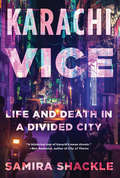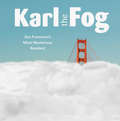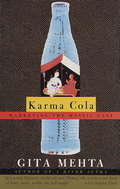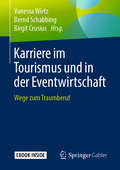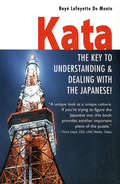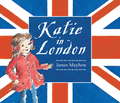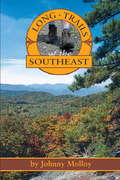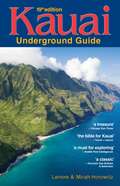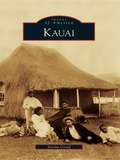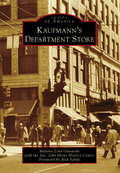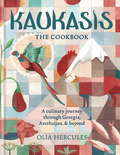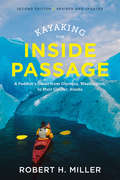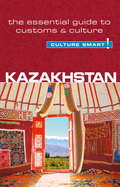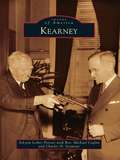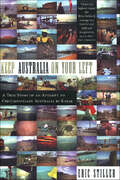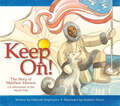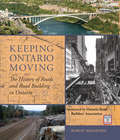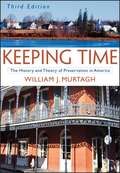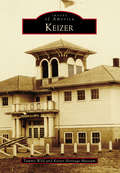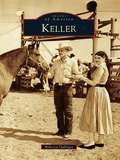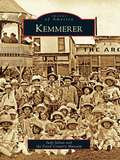- Table View
- List View
Karachi Vice: Life and Death in a Divided City
by Samira ShackleA fast-paced, hair-raising journey around Karachi in the company of those who know the city inside out - from an electrifying new voice in narrative non-fiction. Karachi. Pakistan&’s largest city is a sprawling metropolis of twenty million people, twice the size of New York City. It is a place of political turbulence in which those who have power wield it with brutal and partisan force. It takes an insider to know where is safe, who to trust, and what makes Karachi tick. In this powerful debut, Samira Shackle explores the city of her mother&’s birth in the company of a handful of Karachiites. Among them is Safdar the ambulance driver, who knows the city&’s streets and shortcuts intimately and will stop at nothing to help his fellow citizens. There is Parveen, the activist whose outspoken views on injustice repeatedly lead her towards danger. And there is Zille, the hardened journalist whose commitment to getting the best scoops puts him at increasing risk. Their individual experiences unfold and converge, as Shackle tells the bigger story of Karachi over the past decade as it endures a terrifying crime wave: a period in which the Taliban arrive in Pakistan, adding to the daily perils for its residents and pushing their city into the international spotlight. Writing with intimate local knowledge and a global perspective, Shackle paints a vivid portrait of one of the most complex and compelling cities in the world, a city where the borders blur between politicians and gangsters and between lawful and unlawful, as dangerous new forces of violent extremism are pitted against old networks of power.
Karl the Fog: San Francisco's Most Mysterious Resident
by Karl the FogSan Francisco, home of cable cars, the Golden Gate Bridge—and its quintessential cool gray fog. As a resident of the Silicon Valley, Karl the Fog naturally uses Twitter and Instagram accounts to document his comings and goings and the beauty of the city he loves (except for when it's sunny). Amassing roughly half a million followers across social platforms, Karl the Fog's witty takes on San Francisco paired with beautiful, evocative photography have earned him celebrity status in the Bay Area and beyond. In this, Karl's very first book, he details his family's history and shares more than 50 scenic selfies along with brand-new, entertaining appreciations of the city, lifting his veil of mist-ery and celebrating San Francisco as only he can.
Karma Cola
by Gita MehtaBeginning in the late '60s, hundreds of thousands of Westerners descended upon India, disciples of a cultural revolution that proclaimed that the magic and mystery missing from their lives was to be found in the East. An Indian writer who has also lived in England and the United States, Gita Mehta was ideally placed to observe the spectacle of European and American "pilgrims" interacting with their hosts. When she finally recorded her razor sharp observations in Karma Cola, the book became an instant classic for describing, in merciless detail, what happens when the traditions of an ancient and longlived society are turned into commodities and sold to those who don't understand them.In the dazzling prose that has become her trademark, Mehta skewers the entire Spectrum of seekers: The Beatles, homeless students, Hollywood rich kids in detox, British guilt-trippers, and more. In doing so, she also reveals the devastating byproducts that the Westerners brought to the villages of rural lndia -- high anxiety and drug addiction among them.Brilliantly irreverent, Karma Cola displays Gita Mehta's gift for weaving old and new, common and bizarre, history and current events into a seamless and colorful narrative that is at once witty, shocking, and poignant.From the Trade Paperback edition.
Karriere im Tourismus und in der Eventwirtschaft: Wege zum Traumberuf
by Vanessa Wirtz Bernd Schabbing Birgit CrusiusDieses Buch gibt Ihnen einen praxisnahen Einblick in Karrieren der Tourismus- und Eventwirtschaft Spannend, vielfältig und erlebnisreich – die Tourismus- und Eventwirtschaft ist eine besonders dynamische Branche. Das macht sich auch durch ihr jährliches Wachstum bemerkbar. Da ist es keine Überraschung, dass viele Menschen in diesem Berufszweig ihr persönliches Glück finden wollen. Dieses Buch bietet Ihnen einen umfassenden Einblick in verschiedene Karrieren in der Tourismus- und Eventwirtschaft. Im Fokus stehen 19 individuelle Erfahrungsberichte von Absolventen der International School of Management (ISM), mit denen Sie erfolgreiche Karrierewege nachverfolgen können. So bekommen Sie einen Branchenüberblick zum Tourismus- und Eventmarkt. Außerdem geben Ihnen Karriereberater der ISM Expertentipps für einen erfolgreichen Karriereeinstieg in der Tourismus- und Eventwirtschaft.Theoretisches Wissen und BrancheneinblickeZunächst erfahren Sie in diesem Buch mehr über die theoretischen Grundlagen von Karrieren in der Tourismus- und Eventwirtschaft. Die Herausgeber liefern Ihnen einen Branchenüberblick mit Daten und Fakten und erläutern die zunehmende Bedeutung von Events. Anschließend bekommen Sie in Interviewform Einblick in verschiedene Berufszweige und die Voraussetzungen für eine erfolgreiche Berufslaufbahn:Karrieren im LuftverkehrsmanagementKarrieren in der HotellerieKarrieren im EventmanagementKarrieren bei Reiseveranstaltern und ReisemittlernKarrieren im ReiseverkehrNeue MedienDie wichtigsten Learnings und der richtige KarrierewegNützliche Entscheidungshilfen bei der Berufswahl Zwei Fachbeiträge erläutern, welche Persönlichkeitsmerkmale eine erfolgreiche Karriere in der Tourismusbranche positiv beeinflussen. Zudem können Sie sich in diesem Buch über die aktuelle Anforderungen und Erwartungen an Studierende informieren und leichter den für Sie besten Karriereweg einschlagen. Abgerundet wird dieser Karriere-Ratgeber durch die Vorstellung des Studiengangs „Tourism & Event Management“. Mit dieser umfassenden Darstellung von aktuellen Themen und zukünftigen Trends zu Ausbildung und Studium in der Tourismusbranche richtet sich dieser Sammelband in erster Linie an Auszubildende, Studieninteressierte und Studierende, aber auch an Praktiker in der Tourismus- und Eventbranche.
Kata
by Boye Lafayette De MenteTokyoIn this first book ever to explain why the Japanese think and behave the way they do, veteran Japanologist Boye Lafayette De Mente, unlocks the mystery of kata--the cultural molds that have traditionally shaped and defined the attitudes, behavior, and character of the Japanese and are primarily responsible for the traits and talents that make them different from other people.<P><P>In 70 brief essays, ranging from "The Art of Bowing" and "Importance of the Apology" to "The Compulsion for Quality" and "Exchanging Name-Cards," the author looks at the origin, nature, use, and influence of kata (literally the form and order of doing things) in Japanese life and how this cultural conditioning causes the Japanese to think and react in the way they do. Because all relations with the Japanese are influenced by kata, the key to dealing with the Japanese in personal, business or political matters requires knowing how to work within the confines of kata and when to induce or compel them to break the kata and behave in a non-Japanese way.
Katie In London (Katie)
by James MayhewCome on a magical tour with Katie and discover London's most famous sights!When Katie and her brother Jack visit London with Grandma, something very unexpected happens . . . One of the Trafalgar Square lions comes to life and takes them on a wonderful tour of all the best sights! Including Buckingham Palace, the Tower of London, Big Ben and the London Eye.'London comes to life in this magical adventure' - Independent Featuring many of London's key landmarks, this storybook has become a bestselling introduction to London, and is perfect for children visiting the city for the first time.
Kauai Trails
by Kathy MoreyFrom enchanted Hanelei Bay to the rainbows of Waimea Canyon, from Wailua Falls to the sculptured NaPali Coast, Kaua'i has an unmatchable landscape and miles of trails for hikers and backpackers. This new edition details 59 hikes: you'll walk along steep cliffs above turquoise water, relax next to immense waterfalls, drink in the sweet scent of Kaua'i hibiscus, and stroll on beaches at sunrise.
Kauai Underground Guide
by Lenore W. Horowitz Mirah A. HorowitzPraised as "the bible" for Kauai (Travel & Leisure) and "a must for visitors" (Honolulu Advertiser), the newest edition (the 19th) of Kauai Underground Guide remains the longtime favorite for finding Kauai's best beaches, restaurants, tours, activities, adventures, and hidden beauty spots. With "everything you need to know" to discover Kauai (Hawaii Magazine), it's packed with adventure ideas and money-saving tips. Great for explorers - essential for families.* More than 250,000 books sold - the original guidebook to Kauai* Colorful maps for easy reference* 'Don't miss' day plans for each island area, highlighting the most exciting adventures and activities* Easy-to-follow directions to the best beaches and hidden places* Handy charts for choosing restaurants, activities and adventures* Advice for navigating the island's micro-climates to find the best weather* Exclusive, free CD sampler by Hawaiian singing star Kealii Reichel - the perfect rental car companion* More detailed descriptions of where to go and what to see and do than any other guidebook* Recommendations for traveling with children* Not a franchise or part of a series, the authors write only about Kauai* Sales help non-profit agencies benefiting Kauai's children
Kauai: 100 Years In Postcards (Images of America)
by Stormy CozadCapt. James Cook stood on his ship gazing at the coastline of Kauai and the Hawaiian village of Waimea in 1778. Kauai was its own kingdom then, and King Kaumualii--the king of Kauai who challenged Kamehameha and managed to keep Kauai from being conquered by him--would not be born for two more years. The oldest and northernmost of the main Hawaiian Islands, Kauai did not see well-meaning missionaries until 1820. From the moment Cook put Kauai on the map, it has gathered admirers from all over the world who come to experience its exquisite beauty and wonder. Fortunately, many photographers have had their own love affairs with Kauai, leaving a vast amount of documentation.
Kaufmann's Department Store (Images of America)
by Melanie Linn Gutowski The Senator John Heinz History Center Rick SebakKaufmann's Department Store was a force in Pittsburgh retail from its humble beginnings in 1871 until its merger with Federated Department Stores in 2006. The "Big Store" downtown was a landmark shopping emporium with 12 floors of everything from cosmetics and groceries to wedding gowns and lawn mowers. Under the leadership of Edgar J. Kaufmann and his wife, Liliane, the store became a forum for exhibitions of art, cutting-edge technology, and Parisian haute couture. Generations of Pittsburghers hold fond memories of meeting friends and family under the famous Kaufmann's clock to lunch at the Tic Toc Restaurant, pick up cookies at the Arcade Bakery, or peer into the store's enchanting Christmas window displays each December.
Kaukasis The Cookbook: The culinary journey through Georgia, Azerbaijan & beyond
by Olia HerculesOver 100 recipes from Georgia and beyond.
Kavithri: Outcast. Underdog. Survivor. (Ghosts of Ethuran)
by Aman J. BediAn action-packed South Asian epic fantasy featuring necromancers, jinn, and one seriously fearless heroine...Meet Kavithri. Outcast. Underdog. Survivor.Kavi is a Taemu. Her people, once feared berserkers and the spearhead of a continent-spanning invasion, are the dregs of Raayan society. Their spirits crushed. Their swords broken. Their history erased.But Kavi has a dream and a plan. She will do whatever it takes to earn a place at the secretive mage academy, face the Jinn within its walls, and gain the power to rise above her station and drag her people out of the darkness.Except power and knowledge come at a cost, and the world no longer needs a Taemu who can fight. So they will break her. Beat her down to her knees. And make her bleed.But if blood is what they want, Kavi will give them blood. She will give them violence. She will show them a berserker's fury.And she will make them remember her name.An action-packed and empowering South Asian fantasy epic that fans of Jade City will love. An underdog story like no other - Kavithri will remind you of fantasy heroes like Arya Stark, Gideon the Ninth and Kaladin Stormblessed.'A richly detailed, darkly gritty world, and Kavi is such a compelling, sharp, and original heroine' Sunyi Dean, Sunday Times bestselling author of The Bone Eaters'An impressive debut in every sense - this grim and relentless exploration of colonialism, power, resistance and courage will leave readers shaken' Samit Basu'A journey that seamlessly packs South Asian lore and progression fantasy into a relentless rollercoaster' Gourav Mohanty'Majestic: a pacy, visceral tale . . . powered by a heroine with lashings of charm and grit in equal measure' David Wragg'A striking examination of class, caste, and colonialism by way of wondrously creative magic and an underdog you can't help but root for' J.T. Greathouse, British Fantasy Award nominated author
Kavithri: Outcast. Underdog. Survivor. (Ghosts of Ethuran)
by Aman J. BediAn action-packed South Asian epic fantasy featuring necromancers, jinn, and one seriously fearless heroine...Meet Kavithri. Outcast. Underdog. Survivor.Kavi is a Taemu. Her people, once feared berserkers and the spearhead of a continent-spanning invasion, are the dregs of Raayan society. Their spirits crushed. Their swords broken. Their history erased.But Kavi has a dream and a plan. She will do whatever it takes to earn a place at the secretive mage academy, face the Jinn within its walls, and gain the power to rise above her station and drag her people out of the darkness.Except power and knowledge come at a cost, and the world no longer needs a Taemu who can fight. So they will break her. Beat her down to her knees. And make her bleed.But if blood is what they want, Kavi will give them blood. She will give them violence. She will show them a berserker's fury.And she will make them remember her name.An action-packed and empowering South Asian fantasy epic that fans of Jade City will love. An underdog story like no other - Kavithri will remind you of fantasy heroes like Arya Stark, Gideon the Ninth and Kaladin Stormblessed.'A richly detailed, darkly gritty world, and Kavi is such a compelling, sharp, and original heroine' Sunyi Dean, Sunday Times bestselling author of The Bone Eaters'An impressive debut in every sense - this grim and relentless exploration of colonialism, power, resistance and courage will leave readers shaken' Samit Basu'A journey that seamlessly packs South Asian lore and progression fantasy into a relentless rollercoaster' Gourav Mohanty'Majestic: a pacy, visceral tale . . . powered by a heroine with lashings of charm and grit in equal measure' David Wragg'A striking examination of class, caste, and colonialism by way of wondrously creative magic and an underdog you can't help but root for' J.T. Greathouse, British Fantasy Award nominated author
Kayaking the Inside Passage (Second Edition): A Paddler's Guide From Puget Sound, Washington, To Glacier Bay, Alaska
by Robert H. MillerAn indispensable companion for an incredible journey, newly updated and in color The Inside Passage is something of a holy grail for contemporary sea kayakers. It is without question the most scenic and challenging paddling trip in North America. Revised with route updates, map improvements, and stunning color photography, Kayaking the Inside Passage will aid kayakers in planning paddling trips on the rugged Pacific artery that runs along the western edge of North America. Robert Miller has traversed these waters for decades and created this inimitable guide to kayaking the entire 1,300- mile length of the Inside Passage along one select route with some alternate variations. No other paddling guide covers the entire length of the Inside Passage. Miller includes complete historical and natural background, along with proficiency and equipment recommendations. Paddlers will get the most out of their experience with the advice and hard- won insight of a seasoned veteran.
Kazakhstan - Culture Smart!
by Dina ZhansagimovaKazakhstan, one of the largest countries on earth, was long hidden from the rest of the world behind the Iron Curtain, and continued to remain unnoticed among the "stans" of Central Asia that gained independence from the Soviet Union in the early 1990s. Now, twenty years later, it has emerged as a modern state with far-reaching ambitions. It has developed rapidly over the last decade, raising a brand-new capital in the middle of its vast, empty grasslands, and stepping up to take the leading position in the region. Blessed with great reserves of oil, gas, and mineral resources, it is politically and economically stable, and the richest country in Central Asia. The seemingly endless expanse of the Kazakh Steppe takes visitors by surprise. In the east and southeast the terrain eventually changes to picturesque highlands and mountains, providing natural habitats for a number of rare animal and bird species. Once home to ancient civilizations, this immense land has yielded a wealth of archaeological artefacts. The modern Kazakh people emerged from the rise and fall of a succession of medieval Turkic states before being absorbed into the Russian Empire. They were pastoral nomads, self-sufficient, free, and famously adaptable. Their openness and generosity of spirit have survived against all the odds of a grim history. Today Kazakhstan is open for business, and receptive again to outside cultural influences. Culture Smart! Kazakhstan introduces Western readers to this complex, unknown people. It guides you through their traditions, customs, and social values. It describes how they behave at work, at home, at leisure, and on the street, and what they eat and drink. There are vital tips on communicating, and invaluable insights into Kazakhstan's dynamic business culture and economy.
Kearney (Images of America)
by Arlynn Leiber Presser Rev Michael Coglan Charles H. SeymourKearney, Missouri, is just 25 miles northeast of Kansas City, and though it's a quiet farming and ranching community, its close proximity to the downtown area makes it the perfect place for commuters who want a small town to come home to. Officially incorporated in 1869 and most likely named for Charles E. Kearney, president of the Kansas City and Cameron Railroad, Kearney is best known as the birthplace of outlaw Jesse James and his brother Frank. The James brothers joined with the Younger brothers to form a gang that terrorized the Midwest in the chaotic years following the Civil War. Although the James brothers worked only to enrich their own fortunes, a Robin Hood mythology has developed around them. Kearney encourages the celebration of the era, if not the actual man. Jesse James Festival in September is a time for watching rodeos, eating kettle corn, playing mud volleyball, and enjoying world-class concerts at the town's amphitheater. Kearney is the fastest-growing city in Missouri and a point of access to other parts of the state. Its schools are among the best in the country, and the village takes pride in its "business friendly" attitude.
Keep Australia On Your Left: A True Story of an Attempt to Circumnavigate Australia by Kayak
by Eric StillerKeep Australia on Your Left is a story of friendship forged--and sustained--under demanding circumstances. It is also the personal portrait of Eric Stiller's journey around a continent...and into himself."You mad bastards. You mad bloody bastards."The challenge? Paddle a kayak around Australia.As Eric Stiller and Tony Brown would discover, the attempt would be a fascinating, frustrating, maddening, and at times hilarious crawl around what many consider the most beautiful but treacherous coastline in the world. Swamped by high waves and rain, hampered by faulty technology, blown off course, baked by a broiling sun or chilled by sub-zero temperatures, battling loneliness and exhaustion--and sometimes each other--it would be the most demanding emotional and physical challenge either had ever attempted. In short, it was the adventure of a lifetime!At the Publisher's request, this title is being sold without Digital Rights Management Software (DRM) applied.
Keep Calm and Pedal On
by VariousIn the never ending streams of traffic and the choking fumes of pollution this book gives the average cycle enthusiast or, indeed novice, a collection of quotes, sayings and proverbs on even more reasons why one should get on their bike.In the format of the bestselling Keep Calm and Carry On, Keep Calm and Pedal On is the perfect gift for keen bikers. It is a book that will give a cyclist comfort in the knowledge that their passion for bikes is shared with some of world's greatest leaders, personalities and authors.After all, in the words of John F. Kennedy, 'Nothing compares to the simple pleasure of a bike ride.'
Keep On!: The Story Of Matthew Henson, Co-discoverer Of The North Pole
by Deborah Hopkinson Stephen AlcornThis stunning picture book offers a riveting account of African-American explorer Matthew Henson’s 1909 journey to the North Pole with Admiral Peary. Matthew Henson was born just after the Civil War, a time when slavery had been abolished, but few opportunities were available for black people. As a child, Henson exhibited a yearning for adventure, embarking at age thirteen on a five-year voyage sailing the seven seas. Henson’s greatest adventure began when Robert Peary invited him to join an expedition to the North Pole. After many storms, injuries, and unimaginable cold, on April 1, Peary, Henson, and four Inuit men began the final 133-mile push to the Pole. Award-winning author Deborah Hopkinson pays tribute to a great but under-recognized figure from America’s past in this remarkable story. Illustrator Stephen Alcorn’s large-format, stylized ink-and-watercolor illustrations capture all the action. Excerpts from Henson’s expedition diaries, a time line, and an epilogue place the story in its historical context.
Keep On!: The Story of Matthew Henson, Co-Discoverer of the North Pole
by Deborah HopkinsonThis stunning picture book offers a riveting account of African American explorer Matthew Henson's 1909 journey to the North Pole with Admiral Peary. Matthew Henson was born just after the Civil War, a time when slavery had been abolished, but few opportunities were available for Black people. As a child, Henson exhibited a yearning for adventure, embarking at age thirteen on a five-year voyage sailing the seven seas. But Henson's greatest adventure began when Robert Peary invited him to join an expedition to the North Pole. After many storms, injuries, and unimaginable cold, on April 1, Peary, Henson, and four Inuit men began the final 133-mile push to the Pole. This fascinating tale from award-winning nonfiction author Deborah Hopkinson is paired with beautiful artwork from Stephen Alcorn. Perfect for Black history and exploration units.
Keeping Ontario Moving: The History of Roads and Road Building in Ontario
by Robert Bradford<p>A comprehensive history of roads and road-building in Ontario. <p>In this beautifully illustrated book, virtually every facet of the road building industry in Ontario is discussed, from labour relations to safety, politics, and financing. Follow the history of road-building technology from the first crude trails hacked through dense forests by homesteaders to the corduroy roads, planks roads, stone roads, macadam pavements, hot mix asphalt pavements, and concrete roads. See how the engineering and construction of bridges has progressed from the first jack pine logs placed across a stream to the complex structures that span international waters and thousands of rivers today. Follow the development of construction equipment from the first steam shovels and cable-operated machines of the late 1800s to diesel-powered machines in the 1940s and later hydraulics. Meet the companies that made the equipment and the people who sold and rented it. <p>From the 1930s forward the early story of roads is told largely by the people who lived and made the history. Over 120 contractors, engineers, government officials, and others were interviewed and the last eighty years of the industry’s history unfolds in the way they remember it. Share their memories and stories, some hilarious and some tragic, as they talk about their projects, their businesses, their successes, and their hardships.</p>
Keeping Time: The History and Theory of Preservation in America
by William J. MurtaghThe historic preservation movement has had a huge influence on America's built landscape for the past thirty years. Discover the cornerstone primer on the topic -- Keeping Time. This edition features a wealth of new material, including new chapters on preservation values in oral-based cultures, international preservation, and future developments in the field. In addition, you'll find a clear, concise survey of preservation movements history, complete with: Helpful coverage of the theory and practice driving the movement; Expanded material on landscape preservation; and, New information on scientific conservation, cultural corridors, and historic tourism.
Keizer
by Keizer Heritage Museum Tammy WildThe community of Keizer was shaped by the banks of the Willamette River. It was first inhabited by the Kalapuya tribe, and then came fur trappers and early missionaries farther north along the river. Homesteaders arrived in the 1840s. The rich river-bottom farmland remained quiet until the boom of automobiles after World War II. Keizer boasts neither fancy buildings nor brick edifices but proudly carries its spirit of volunteerism and perseverance. Pioneer Thomas Dove Keizur and Oregon senator Charles McNary are noted citizens. The iconic 1916 Keizer schoolhouse, now Keizer Heritage Center, is a cherished landmark. The story of Keizer comprises an account of the settlement of the state of Oregon--from wagon train to a thriving city. Keizer officially became an incorporated city in 1982.
Keller
by Rebecca GallegosIn the late 1800s, pioneers settled in the northeast Texas region of Cross Timbers known as Double Springs. In 1875, Isaac Roberts, a farmer who owned more than 600 acres, left a parcel of his land to A. G. Roberts, who then sold the right-of-way to the Texas and Pacific Railway for $25. A new town was formed, and in 1882, it was named Keller in honor of the railroad foreman who was instrumental in making the area a regular stop along the railroad. With the railroad bringing new visitors and residents, a post office was created in 1888, and new businesses started forming. The Works Progress Administration provided jobs for many Keller residents during the Great Depression, and the results of those projects shaped the way the city looks today. As of 2010, Old Town Keller was undergoing a new phase of revitalization while maintaining its connection to the hardy pioneers that once called Keller home.
Kemmerer: Digging For Western History (Images of America)
by Judy Julian Fossil Country MuseumEstablished in 1897, incorporated in January of 1899, and located in southwest Wyoming, Kemmerer has been a coal-mining community for over 100 years. Kemmerer became the county seat for Lincoln County in 1911 when Uinta County, one of Wyoming's original five counties, was divided. James Cash Penney opened the first J. C. Penney store in Kemmerer on April 12, 1902. During the 1920s, the Kemmerer area became a large center for moonshining and a large supplier of liquor for Chicago and the Midwest. This ended when Prohibition was repealed in 1933. The rich deposits of fossils in the area have long been a point of interest for paleontologists and geologists, amateur and professional, giving Kemmerer the title "Fossil Fish Capital of the World."
